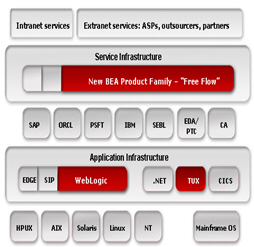BEA's Free Flow

Over at Between the Lines, Dan Farber offers some insight on BEA's new go-to-market strategy. Code-named Project Free Flow, the company's approach is "basically a service infrastructure grid that allows composite applications and services to be composed that are abstracted from the underlying systems and technology. Whereas BEA’s J2EE-based WebLogic is about developing code and compiling, FreeFlow is an SOA environment for modeling business processes and building composite applications without reliance on programmer skills."
BEA Stack View

Farber notes that "BEA is not alone is developing an SOA service infrastructure that allows non-technical business people to compose business processes and modify workflows." He also wonders how much of a differentiator BEA's stance as an "independent" platform provider represents. There's certainly some tough talk on the BEA Web site:
"The industry’s interests cannot be served by the digital imperialism of application or database vendors seeking to perpetuate their agenda. An independent, bias-free provider delivers more choices, is better able to drive and adopt open standards, and collaborates more freely with the entire partner community to deliver a broader range of customer-focused solutions. It’s freer to drive technology in the direction of maximum transparency, flexibility, and cooperation….BEA’s independent infrastructure allows customers to maintain ownership of the intellectual property and labor they’ve invested in custom business logic—without threat of vendor lock-in. If you compose it, compile it or code it, you own it. These ownership rights also provide more freedom in choosing systems and providers, protecting the CIO’s leverage with vendors."
The lure of the independent platform vendor, states Farber, is "less of a deal maker than in the past. Enterprises are looking for integrated solutions with a rapid ROI, not necessarily agnosticism, especially at a time when standards-based computing based on Web services and XML is becoming the norm."
Nevertheless, all efforts to bring development capabilities to business people ("the rest of us") are to be highly welcomed. Such efforts will extend the promise of SOA beyond today's opaque cloisters of enterprise IT.